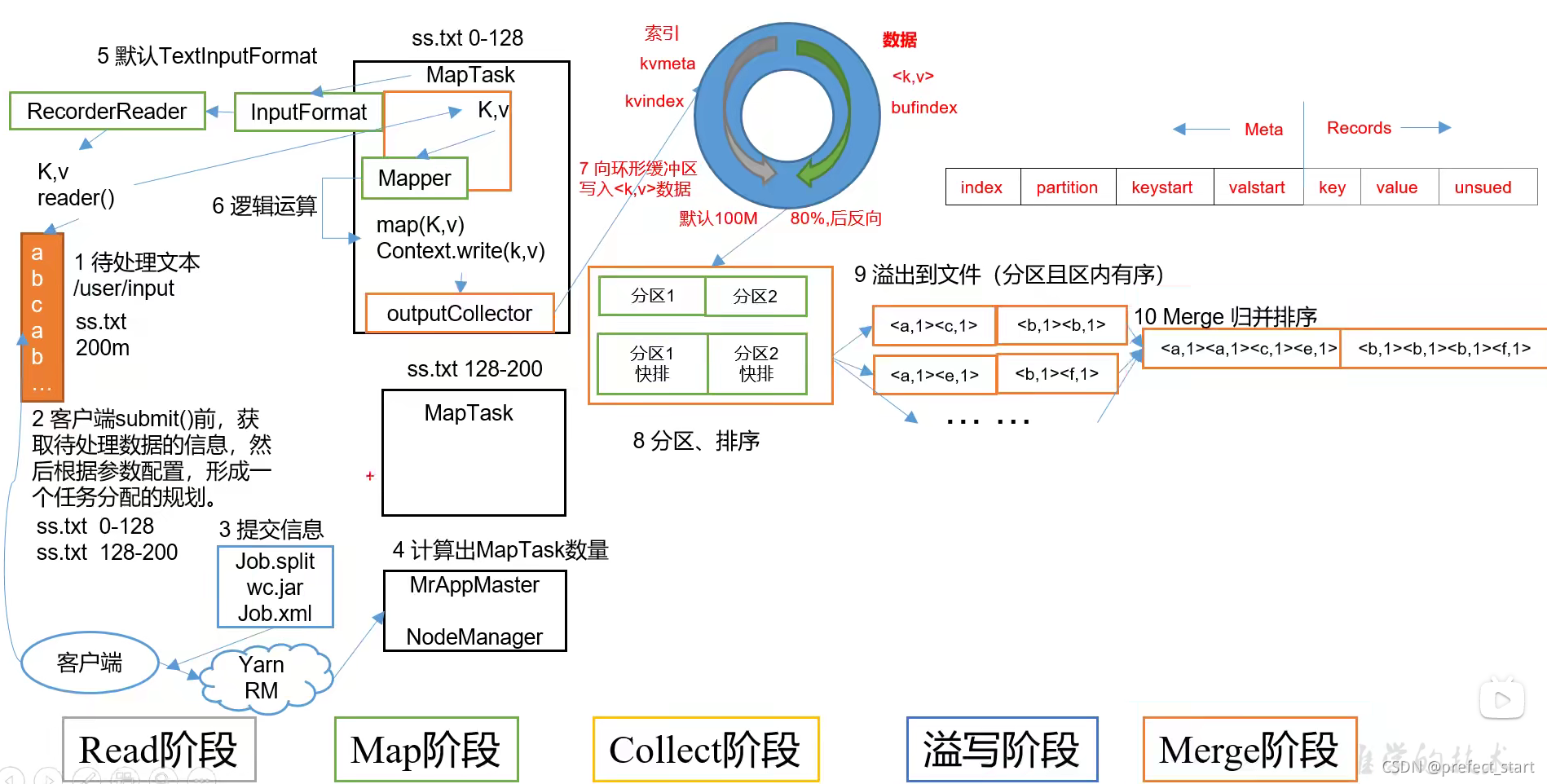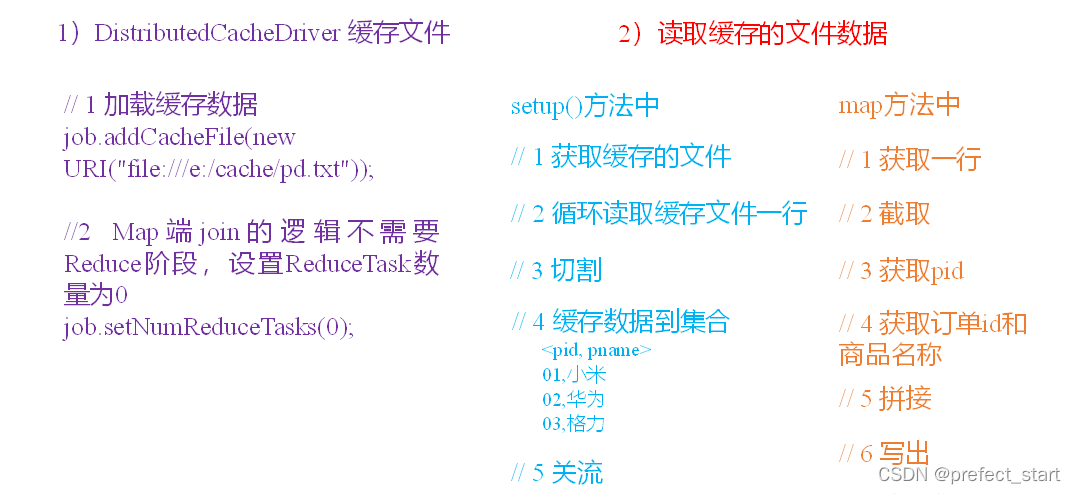1、MapTask工作机制

- Read阶段:MapTask通过InputFormat获得的RecordReader,从输入InputSplit中解析出一个个key/value。
- Map阶段:该节点主要是将解析出的key/value交给用户编写map()函数处理,并产生一系列新的key/value。
- Collect收集阶段:在用户编写map()函数中,当数据处理完成后,一般会调用OutputCollector.collect()输出结果。在该函数内部,它会将生成的key/value分区(调用Partitioner),并写入一个环形内存缓冲区中。
- Spill阶段:即“溢写”,当环形缓冲区满后,MapReduce会将数据写到本地磁盘上,生成一个临时文件。需要注意的是,将数据写入本地磁盘之前,先要对数据进行一次本地排序,并在必要时对数据进行合并、压缩等操作。
溢写阶段详情:
步骤1:利用快速排序算法对缓存区内的数据进行排序,排序方式是,先按照分区编号Partition进行排序,然后按照key进行排序。这样,经过排序后,数据以分区为单位聚集在一起,且同一分区内所有数据按照key有序。
步骤2:按照分区编号由小到大依次将每个分区中的数据写入任务工作目录下的临时文件output/spillN.out(N表示当前溢写次数)中。如果用户设置了Combiner,则写入文件之前,对每个分区中的数据进行一次聚集操作。
步骤3:将分区数据的元信息写到内存索引数据结构SpillRecord中,其中每个分区的元信息包括在临时文件中的偏移量、压缩前数据大小和压缩后数据大小。如果当前内存索引大小超过1MB,则将内存索引写到文件output/spillN.out.index中。 - Merge阶段:当所有数据处理完成后,MapTask对所有临时文件进行一次合并,以确保最终只会生成一个数据文件。当所有数据处理完后,MapTask会将所有临时文件合并成一个大文件,并保存到文件output/file.out中,同时生成相应的索引文件output/file.out.index。
在进行文件合并过程中,MapTask以分区为单位进行合并。对于某个分区,它将采用多轮递归合并的方式。每轮合并mapreduce.task.io.sort.factor(默认10)个文件,并将产生的文件重新加入待合并列表中,对文件排序后,重复以上过程,直到最终得到一个大文件。让每个MapTask最终只生成一个数据文件,可避免同时打开大量文件和同时读取大量小文件产生的随机读取带来的开销。
2、 ReduceTask工作机制

- Copy阶段:ReduceTask从各个MapTask上远程拷贝一片数据,并针对某一片数据,如果其大小超过一定阈值,则写到磁盘上,否则直接放到内存中。
- Sort阶段:在远程拷贝数据的同时,ReduceTask启动了两个后台线程对内存和磁盘上的文件进行合并,以防止内存使用过多或磁盘上文件过多。按照MapReduce语义,用户编写reduce()函数输入数据是按key进行聚集的一组数据。为了将key相同的数据聚在一起,Hadoop采用了基于排序的策略。由于各个MapTask已经实现对自己的处理结果进行了局部排序,因此,ReduceTask只需对所有数据进行一次归并排序即可。
- Reduce阶段:reduce()函数将计算结果写到HDFS上。
3、ReduceTask并行度决定机制
MapTask并行度由切片个数决定,切片个数由输入文件和切片规则决定。
1)设置ReduceTask并行度(个数)
ReduceTask的并行度同样影响整个Job的执行并发度和执行效率,但与MapTask的并发数由切片数决定不同,ReduceTask数量的决定是可以直接手动设置:
// 默认值是1,手动设置为4
job.setNumReduceTasks(4);
2)实验:测试ReduceTask多少合适
(1)实验环境:1个Master节点,16个Slave节点:CPU:8GHZ,内存: 2G
(2)实验结论:
表 改变ReduceTask(数据量为1GB)
MapTask =16
ReduceTask 1 5 10 15 16 20 25 30 45 60
总时间 892 146 110 92 88 100 128 101 145 104
3)注意事项

4、MapTask & ReduceTask源码解析
1)MapTask源码解析流程
=================== MapTask ===================
context.write(k, NullWritable.get()); //自定义的map方法的写出,进入
output.write(key, value);
//MapTask727行,收集方法,进入两次
collector.collect(key, value,partitioner.getPartition(key, value, partitions));
HashPartitioner(); //默认分区器
collect() //MapTask1082行 map端所有的kv全部写出后会走下面的close方法
close() //MapTask732行
collector.flush() // 溢出刷写方法,MapTask735行,提前打个断点,进入
sortAndSpill() //溢写排序,MapTask1505行,进入
sorter.sort() QuickSort //溢写排序方法,MapTask1625行,进入
mergeParts(); //合并文件,MapTask1527行,进入
collector.close(); //MapTask739行,收集器关闭,即将进入ReduceTask
2)ReduceTask源码解析流程
=================== ReduceTask ===================
if (isMapOrReduce()) //reduceTask324行,提前打断点
initialize() // reduceTask333行,进入
init(shuffleContext); // reduceTask375行,走到这需要先给下面的打断点
totalMaps = job.getNumMapTasks(); // ShuffleSchedulerImpl第120行,提前打断点
merger = createMergeManager(context); //合并方法,Shuffle第80行
// MergeManagerImpl第232 235行,提前打断点
this.inMemoryMerger = createInMemoryMerger(); //内存合并
this.onDiskMerger = new OnDiskMerger(this); //磁盘合并
rIter = shuffleConsumerPlugin.run();
eventFetcher.start(); //开始抓取数据,Shuffle第107行,提前打断点
eventFetcher.shutDown(); //抓取结束,Shuffle第141行,提前打断点
copyPhase.complete(); //copy阶段完成,Shuffle第151行
taskStatus.setPhase(TaskStatus.Phase.SORT); //开始排序阶段,Shuffle第152行
sortPhase.complete(); //排序阶段完成,即将进入reduce阶段 reduceTask382行
reduce(); //reduce阶段调用的就是我们自定义的reduce方法,会被调用多次
cleanup(context); //reduce完成之前,会最后调用一次Reducer里面的cleanup方法
5、 Join应用
5.1、 Reduce Join
Map端的主要工作:为来自不同表或文件的key/value对,打标签以区别不同来源的记录。然后用连接字段作为key,其余部分和新加的标志作为value,最后进行输出。
Reduce端的主要工作:在Reduce端以连接字段作为key的分组已经完成,我们只需要在每一个分组当中将那些来源于不同文件的记录(在Map阶段已经打标志)分开,最后进行合并就ok了。
5.2、 Reduce Join案例实操
5.2.1、需求
订单数据表t_order
id pid amount
1001 01 1
1002 02 2
1003 03 3
1004 01 4
1005 02 5
1006 03 6
商品信息表t_product
pid pname
01 小米
将商品信息表中数据根据商品pid合并到订单数据表中
最终数据形式
id pname amount
1001 小米 1
1004 小米 4
1002 华为 2
1005 华为 5
1003 格力 3
1006 格力 6
5.2.2、分析
通过将关联条件作为Map输出的key,将两表满足Join条件的数据并携带数据所来源的文件信息,发往同一个ReduceTask,在Reduce中进行数据的串联。

5.2.3、代码实现
bean
package com.song.join;
import lombok.Data;
import org.apache.hadoop.io.Writable;
import java.io.DataInput;
import java.io.DataOutput;
import java.io.IOException;
@Data
public class TableBean implements Writable {
private String id; //订单id
private String pid; //产品id
private int amount; //产品数量
private String pname; //产品名称
private String flag; //判断是order表还是pd表的标志字段
public TableBean() {
}
@Override
public String toString() {
return id + "\t" + pname + "\t" + amount;
}
@Override
public void write(DataOutput out) throws IOException {
out.writeUTF(id);
out.writeUTF(pid);
out.writeInt(amount);
out.writeUTF(pname);
out.writeUTF(flag);
}
@Override
public void readFields(DataInput in) throws IOException {
this.id = in.readUTF();
this.pid = in.readUTF();
this.amount = in.readInt();
this.pname = in.readUTF();
this.flag = in.readUTF();
}
}
mapper
package com.song.join;
import org.apache.hadoop.io.LongWritable;
import org.apache.hadoop.io.Text;
import org.apache.hadoop.mapreduce.InputSplit;
import org.apache.hadoop.mapreduce.Mapper;
import org.apache.hadoop.mapreduce.lib.input.FileSplit;
import java.io.IOException;
public class TableMapper extends Mapper<LongWritable, Text, Text, TableBean> {
private String filename;
private Text outK = new Text();
private TableBean outV = new TableBean();
@Override
protected void setup(Context context) throws IOException, InterruptedException {
//获取对应文件名称
InputSplit split = context.getInputSplit();
FileSplit fileSplit = (FileSplit) split;
filename = fileSplit.getPath().getName();
}
@Override
protected void map(LongWritable key, Text value, Context context) throws IOException, InterruptedException {
//获取一行
String line = value.toString();
//判断是哪个文件,然后针对文件进行不同的操作
if (filename.contains("order")) { //订单表的处理
String[] split = line.split("\t");
//封装outK
outK.set(split[1]);
//封装outV
outV.setId(split[0]);
outV.setPid(split[1]);
outV.setAmount(Integer.parseInt(split[2]));
outV.setPname("");
outV.setFlag("order");
} else { //商品表的处理
String[] split = line.split("\t");
//封装outK
outK.set(split[0]);
//封装outV
outV.setId("");
outV.setPid(split[0]);
outV.setAmount(0);
outV.setPname(split[1]);
outV.setFlag("pd");
}
//写出KV
context.write(outK, outV);
}
}
reducer
package com.song.join;
import org.apache.commons.beanutils.BeanUtils;
import org.apache.hadoop.io.NullWritable;
import org.apache.hadoop.io.Text;
import org.apache.hadoop.mapreduce.Reducer;
import java.io.IOException;
import java.lang.reflect.InvocationTargetException;
import java.util.ArrayList;
public class TableReducer extends Reducer<Text, TableBean, TableBean, NullWritable> {
@Override
protected void reduce(Text key, Iterable<TableBean> values, Context context) throws IOException, InterruptedException {
ArrayList<TableBean> orderBeans = new ArrayList<>();
TableBean pdBean = new TableBean();
for (TableBean value : values) {
//判断数据来自哪个表
if ("order".equals(value.getFlag())) { //订单表
//创建一个临时TableBean对象接收value
TableBean tmpOrderBean = new TableBean();
try {
BeanUtils.copyProperties(tmpOrderBean, value);
} catch (IllegalAccessException e) {
e.printStackTrace();
} catch (InvocationTargetException e) {
e.printStackTrace();
}
//将临时TableBean对象添加到集合orderBeans
orderBeans.add(tmpOrderBean);
} else { //商品表
try {
BeanUtils.copyProperties(pdBean, value);
} catch (IllegalAccessException e) {
e.printStackTrace();
} catch (InvocationTargetException e) {
e.printStackTrace();
}
}
}
//遍历集合orderBeans,替换掉每个orderBean的pid为pname,然后写出
for (TableBean orderBean : orderBeans) {
orderBean.setPname(pdBean.getPname());
//写出修改后的orderBean对象
context.write(orderBean, NullWritable.get());
}
}
}
driver
package com.song.join;
import org.apache.hadoop.conf.Configuration;
import org.apache.hadoop.fs.Path;
import org.apache.hadoop.io.NullWritable;
import org.apache.hadoop.io.Text;
import org.apache.hadoop.mapreduce.Job;
import org.apache.hadoop.mapreduce.lib.input.FileInputFormat;
import org.apache.hadoop.mapreduce.lib.output.FileOutputFormat;
import java.io.IOException;
public class TableDriver {
public static void main(String[] args) throws IOException, ClassNotFoundException, InterruptedException {
Job job = Job.getInstance(new Configuration());
job.setJarByClass(TableDriver.class);
job.setMapperClass(TableMapper.class);
job.setReducerClass(TableReducer.class);
job.setMapOutputKeyClass(Text.class);
job.setMapOutputValueClass(TableBean.class);
job.setOutputKeyClass(TableBean.class);
job.setOutputValueClass(NullWritable.class);
FileInputFormat.setInputPaths(job, new Path("D:\\test_data\\input"));
FileOutputFormat.setOutputPath(job, new Path("D:\\test_data\\output11"));
boolean b = job.waitForCompletion(true);
System.exit(b ? 0 : 1);
}
}
总结
缺点:这种方式中,合并的操作是在Reduce阶段完成,Reduce端的处理压力太大,Map节点的运算负载则很低,资源利用率不高,且在 Reduce阶段极易产生数据倾斜。
解决方案:Map端实现数据合并。
5.2、 Map Join
5.2.1、使用场景
Map Join适用于一张表十分小、一张表很大的场景。
5.2.2、优点
思考:在Reduce端处理过多的表,非常容易产生数据倾斜。怎么办?
在Map端缓存多张表,提前处理业务逻辑,这样增加Map端业务,减少Reduce端数据的压力,尽可能的减少数据倾斜。
5.2.3、具体办法
采用DistributedCache
(1)在Mapper的setup阶段,将文件读取到缓存集合中。
(2)在Driver驱动类中加载缓存。
//缓存普通文件到Task运行节点。
job.addCacheFile(new URI("file:///e:/cache/pd.txt"));
//如果是集群运行,需要设置HDFS路径
job.addCacheFile(new URI("hdfs://hadoop102:8020/cache/pd.txt"));
5.2.4、Map Join案例实操
5.2.4.1、分析

5.2.4.2、实现代码
mapper
package com.song.map;
import org.apache.commons.lang.StringUtils;
import org.apache.hadoop.fs.FSDataInputStream;
import org.apache.hadoop.fs.FileSystem;
import org.apache.hadoop.fs.Path;
import org.apache.hadoop.io.IOUtils;
import org.apache.hadoop.io.LongWritable;
import org.apache.hadoop.io.NullWritable;
import org.apache.hadoop.io.Text;
import org.apache.hadoop.mapreduce.Mapper;
import java.io.BufferedReader;
import java.io.IOException;
import java.io.InputStreamReader;
import java.net.URI;
import java.util.HashMap;
import java.util.Map;
public class MapJoinMapper extends Mapper<LongWritable, Text, Text, NullWritable> {
private Map<String, String> pdMap = new HashMap<>();
private Text text = new Text();
//任务开始前将pd数据缓存进pdMap
@Override
protected void setup(Context context) throws IOException, InterruptedException {
//通过缓存文件得到小表数据pd.txt
URI[] cacheFiles = context.getCacheFiles();
Path path = new Path(cacheFiles[0]);
//获取文件系统对象,并开流
FileSystem fs = FileSystem.get(context.getConfiguration());
FSDataInputStream fis = fs.open(path);
//通过包装流转换为reader,方便按行读取
BufferedReader reader = new BufferedReader(new InputStreamReader(fis, "UTF-8"));
//逐行读取,按行处理
String line;
while (StringUtils.isNotEmpty(line = reader.readLine())) {
//切割一行
//01 小米
String[] split = line.split("\t");
pdMap.put(split[0], split[1]);
}
//关流
IOUtils.closeStream(reader);
}
@Override
protected void map(LongWritable key, Text value, Context context) throws IOException, InterruptedException {
//读取大表数据
//1001 01 1
String[] fields = value.toString().split("\t");
//通过大表每行数据的pid,去pdMap里面取出pname
String pname = pdMap.get(fields[1]);
//将大表每行数据的pid替换为pname
text.set(fields[0] + "\t" + pname + "\t" + fields[2]);
//写出
context.write(text, NullWritable.get());
}
}
driver
package com.song.map;
import org.apache.hadoop.conf.Configuration;
import org.apache.hadoop.fs.Path;
import org.apache.hadoop.io.NullWritable;
import org.apache.hadoop.io.Text;
import org.apache.hadoop.mapreduce.Job;
import org.apache.hadoop.mapreduce.lib.input.FileInputFormat;
import org.apache.hadoop.mapreduce.lib.output.FileOutputFormat;
import java.io.IOException;
import java.net.URI;
import java.net.URISyntaxException;
public class MapJoinDriver {
public static void main(String[] args) throws IOException, URISyntaxException, ClassNotFoundException, InterruptedException {
// 1 获取job信息
Configuration conf = new Configuration();
Job job = Job.getInstance(conf);
// 2 设置加载jar包路径
job.setJarByClass(MapJoinDriver.class);
// 3 关联mapper
job.setMapperClass(MapJoinMapper.class);
// 4 设置Map输出KV类型
job.setMapOutputKeyClass(Text.class);
job.setMapOutputValueClass(NullWritable.class);
// 5 设置最终输出KV类型
job.setOutputKeyClass(Text.class);
job.setOutputValueClass(NullWritable.class);
// 加载缓存数据
job.addCacheFile(new URI("file:///D:/test_data/cache/pd.txt"));
// Map端Join的逻辑不需要Reduce阶段,设置reduceTask数量为0
job.setNumReduceTasks(0);
// 6 设置输入输出路径
FileInputFormat.setInputPaths(job, new Path("D:\\test_data\\input"));
FileOutputFormat.setOutputPath(job, new Path("D:\\test_data\\output"));
// 7 提交
boolean b = job.waitForCompletion(true);
System.exit(b ? 0 : 1);
}
}
6、 MapReduce开发总结
6.1、输入数据接口:InputFormat
- 默认使用的实现类是:TextInputFormat
- TextInputFormat的功能逻辑是:一次读一行文本,然后将该行的起始偏移量作为key,行内容作为value返回。
- CombineTextInputFormat可以把多个小文件合并成一个切片处理,提高处理效率。
6.2、逻辑处理接口:Mapper
用户根据业务需求实现其中三个方法:map() setup() cleanup ()
6.3、Partitioner分区
- 有默认实现 HashPartitioner,逻辑是根据key的哈希值和numReduces来返回一个分区号;key.hashCode()&Integer.MAXVALUE % numReduces
- 如果业务上有特别的需求,可以自定义分区。
6.4、Comparable排序
- 当我们用自定义的对象作为key来输出时,就必须要实现WritableComparable接口,重写其中的compareTo()方法
- 部分排序:对最终输出的每一个文件进行内部排序。
- 全排序:对所有数据进行排序,通常只有一个Reduce。
- 二次排序:排序的条件有两个。
6.5、Combiner合并
Combiner合并可以提高程序执行效率,减少IO传输。但是使用时必须不能影响原有的业务处理结果。
6.6、逻辑处理接口:Reducer
用户根据业务需求实现其中三个方法:reduce() setup() cleanup ()
6.7、输出数据接口:OutputFormat
- 默认实现类是TextOutputFormat,功能逻辑是:将每一个KV对,向目标文本文件输出一行。
- 用户还可以自定义OutputFormat。